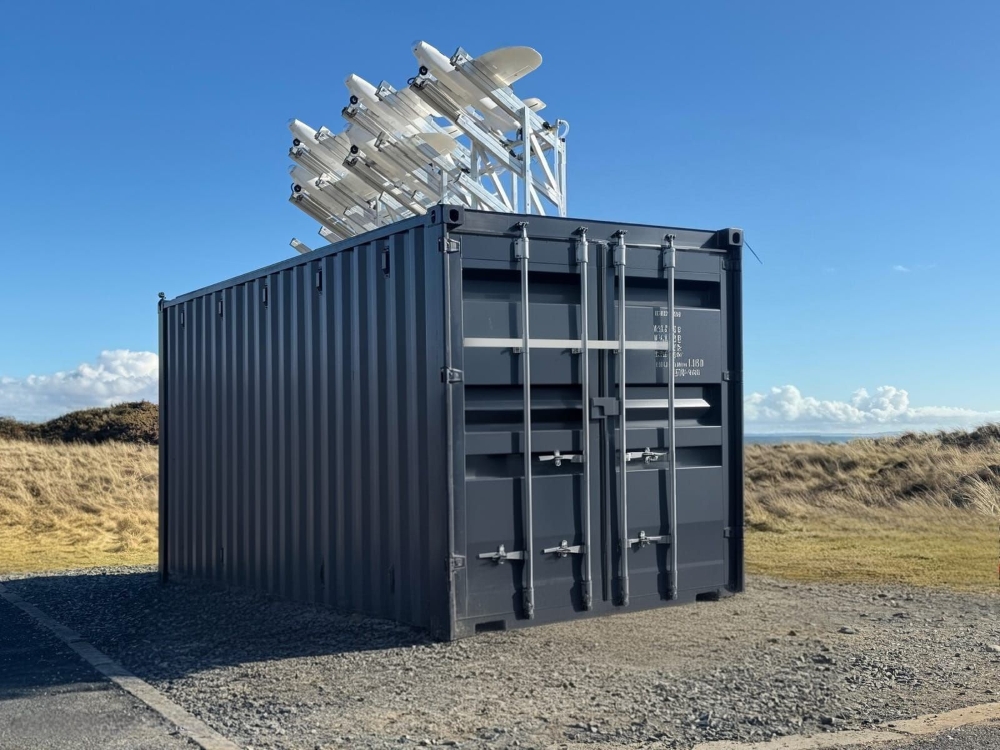
When the Royal Navy first unveiled its concept for the Navy Persistent Operational Deployment System (NavyPODS), a series of container-modules delivering portable capabilities for use on ships and/or ashore, the idea for a containerized UAS / Loitering Munition storage and launch system was already present. A “STRIKE” PODS was one of the very first 5 types to be explored, specifically through prototype Q003. Another PODS, Q004, was described as a more generic UAS storage/launcher.
Very early graphics were provided, providing only a faint idea of how the Q003 and Q004 prototypes would be configured internally. For Q003, the container was to devote some of the space to a C2 station and the rest to storage and a “carousel” launcher for the drones. Q004 was even more similar to the container system Ukraine has eventually used for its attack within Russia, bar for the fact that the racks of drones could afford to exploit the entire height of the container rather than just a concealed gap in the roof to go through possible inspections along the roads.
Little to no public information was subsequently released about early experiments, but by the end of 2023 industry was contacted to deliver a new “concept demonstration of a modular and automated loiter munition and UAS storage and launch POD(S) for multi domain use, to include trials on land and at sea.
The resulting contract award notice, published in January 2024, subsequently revealed that 8 entries were made and 2 received funding, with contract award decisions taken on 28 November 2023. A demonstration concept worth £1,975,000 was awarded to BlueBear Systems Research Ltd, a company that since August of the same year became controlled by Saab UK. A second contract, worth £1,510,000, was awarded to Intrepid Minds Ltd. The notice said that the demonstration campaign would involve 4 live and inert firing trials, but nothing has been reported publicly about the progress of the project ever since.
Late on 4 June, however, IntrepidMinds decided to release an image of its demonstrator, along with very limited information and a cryptic little taunt that will do nothing to ease Russia’s obsession about the involvement of UK “spies” in most of Ukraine’s daring actions. The company wrote “it’s always nice to know that UK doctrine is moving with the times. So following the attack by UA this weekend we can reveal our recent work with the Royal Navy and UK MOD”.
The prototype partially unveiled by the photo uses an angled rack-launched for larger, fixed wing drones rather than rotary wing ones as used by the Ukrainians, but the vague description provided assures that both fixed and rotary wing options can be employed with the ability to launch “volumes” of drones “in seconds”. The demonstrator has been named PHOENIX.
No further information is provided and, so far at least, BlueBear has not shown its own entry, but this glimpse at the work ongoing on the offensive side of the NAVYPODS project evidences both the drive for innovation within the Royal Navy and Royal Marines and a possible connection between Ukraine initiatives and UK military assistance.
We know of at least 13 different NAVYPODS prototype / configurations, including a C2 configuarion (Q002), a Role 2 medical facility (composed by the operatine threatre container, Q006, and by the “services” module, Q007, which delivers Power, Clean Water, Grey and Black waters management, Oxygen and Gases and storage of medical supplies), deployable power solutions, a Heavy-Lift drone support container, etcetera. Keeping track of developments is complicated both by a lack of publicly released information and by the fact that some of the early prototypes have had their configuration and purpose already changed over the years, with Q001 recently re-assigned to the BattleLab in Dorset for use in wider defence experiments. Q005, initially delivered to be a “deployable factory” fitted with 3D printers and adaptive manufacturing, has subsequently been used in 2024 to embark a prototype quantum accelerometer for trials of GPS-denied navigation at sea about the sealift ship HURST POINT.








.png)
